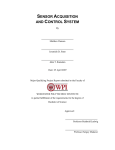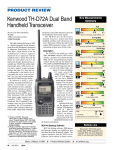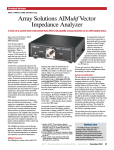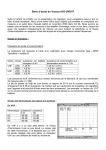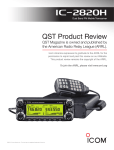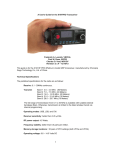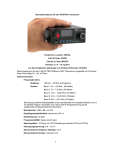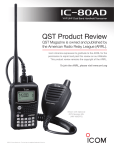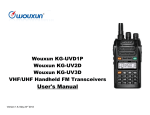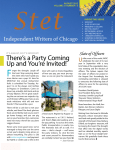Download Wouxun KG-UVD1P Specifications
Transcript
Wouxun KG-UV2D and KG-UVD1P Dual Band Handheld Transceivers Reviewed by Bob Allison, WB1GCM ARRL Test Engineer Wouxun (pronounced, “Oh Sheng”), is a new name on the market. Undoubtedly, many radio amateurs have seen Chinese VHF/UHF handheld transceivers offered via on-line auction services directly from China with a temptingly low price. However tempting, these handheld transceivers transmitted throughout their entire frequency range and lacked basic FCC certification for use in the USA. Wouxun was granted FCC certification for the KG-UVD1P under Part 90 rules for commercial radios, clearing the way for use in the amateur bands. In this review, we will look at the per formance of Wouxun’s KG-UVD1P and KG-UV2D, and ARRL General Counsel Chris Imlay, W3KD, will clear up misconceptions about the use of these radios in the amateur bands. Over the summer I tested the KG-UVD1P at the ARRL Lab and had completed my review when, to my surprise, the KG-UV2D was released to the market. Wouxun’s US distributor, Ed Griffin, W4KMA, informed me that the KG-UV2D is identical to the KG-UVD1P, except for a slightly different case and an improvement to one of the display functions. I got the new model, and Lab test results showed identical performance. This review covers the 2 meter/70 cm version. A 2 meter/1.25 meter version is available as well. Out of the Box After a successful day instructing kit builders at ARRL Expo at the 2010 Dayton Hamvention®, I eagerly checked out the 52 November 2010 KG-UVD1P handheld I had purchased. Inside the box, I found the radio, flexible antenna, battery pack, hand strap, belt clip and a drop-in battery charger. The radio shipped with a charged battery, and soon I heard the locals chatting about the day’s events. As always, read the manual first. You’ll need some time to understand what the manual is trying to say, as the Chinese to English translation is at times puzzling and at other times amusing. For example, the transceiver has two receive frequencies, Bottom Line Wouxun has produced a fully functional dual band handheld transceiver for a lower than usual price. The KG-UV2D has its quirks and as long as the user purchases the programming cable and software, it should provide trouble-free operation. the “Master” frequency (channel A) and the “Vice” frequency (channel B). Needless to say, Wouxun’s English is a lot better than my Chinese. The manual includes a useful Shortcut Operation Sheet for 30 functions. Look Over Unlike most current handheld transceivers, the Wouxun uses a female SMA connector on the 7 inch flexible antenna, which tightens snugly to the top of the body (adapters for other connector types are available). To the right of the antenna is a very bright LED flashlight. Next in line are the rotary encoder and ON/OFF/VOLUME controls. In front of the rotary controls are a green LED that lights when the squelch opens and a red LED indicating TRANSMIT. The left side features the PUSH-TO-TALK switch and two “side keys.” SIDE KEY 1 is used for momentarily turning on the dial lamp, enabling FM broadcast band reception, scanning functions and the SOS channel. SIDE KEY 2 opens the squelch for monitoring weak signals or turns on the flashlight. The right side features speaker (8 W) and mic jacks. Both jacks are used with the optional programming cable. Each side has a battery latch, and both must be pressed firmly downward to detach the battery. There is provision for operating this transceiver with an external dc supply using an optional 12 V battery eliminator. The 1 inch speaker opening on the front panel greets the user with a V shaped grille design. Below that is the A/B button to shift transmit from Channel A to B. You can listen to two frequencies at once, but both receivers are muted upon transmit so this is not a full duplex transceiver. The TDR button just below the speaker switches the receiver from single band to dual band operation. The easy to read 9⁄16 × 11⁄2 inch display is backlit automatically when you press SIDE KEY 2 or any key on the front panel and it stays illuminatred for about 4 seconds. The 16 button keypad includes the function button and shortcuts to some features. The number, # and * keys are fully functional DTMF keys; odd tones are emitted through the speaker if other keys are pressed during transmission. Lab Testing Lab test results are shown in Table 3. These results are for the KG-UV2D, but the KG-UVD1P I tested was virtually identical. Key Measurements Summary 0.11 0.12 0.1 SINAD 0.25 Receiver Sensitivity (12dB SINAD, µV) 86@10 MHz , 82@10 MHz 90 Rx 60 Receiver 3rd-Order Dynamic Range (dB) 69@20 kHz* , 60@20 kHz* 70 Rx 40 Receiver 3rd-Order Dynamic Range (dB) 69 ChRej 50 60 90 Adjacent Channel Rejection (dB) 136** IF 60 136** 110 IF Rejection (dB) 44** 30** Img 60 Image Rejection (dB) 110 720 800 Snd 100 Audio Output (mW) 240 T-R 250 PR052 240 50 Tx-Rx Turnaround Time (ms) Key: ** Off Scale * Measurement noise limited at value shown. 2M 70 cm There were no unexpected problems during testing, but I will note a few things I would like to see improved. While the minimum squelch threshold was 0.05 µV (good), the maximum squelch threshold was 0.15 µV — not useful to block out weak co-channel users. I’d like to see at least 5 µV maximum. I found the S meter to be virtually useless. The radio shows full scale S-meter readings with a very low level signal input, making received signal level comparisons difficult. A more useful sensitivity range would be helpful, especially if working satellites or while participating in radio direction finding activities. I’ve owned handhelds with no S meter, so I didn’t consider this to be a major drawback. The other testing issue was a rather poor ability to reject images, especially on the 70 cm band. While this isn’t a problem with the flexible antenna, images may be an issue if the radio is used with a higher gain external antenna in RF congested areas. Tests showed the KG-UV2D to be very sensitive, with respectable dynamic range figures and good IF rejection. RF output was slightly higher than specified on both bands at full charge, as was audio output from the external speaker jack. The KG-UVD1P and KG-UV2D both meet FCC requirements for spurious signal and harmonic suppression. Spectrally, the KG-UV2D tested even better than the KG-UVD1P. On the Air: It Talks! The Wouxun KG-UV2D can speak either in English or Chinese to announce pressing the key pad numbers or while programming functions, though it does not announce the specific selection made for each function. For example, if I’d like to adjust my RF output power, I press the MENU button and function select is announced. I then rotate the encoder knob around to read TXP (function 04), I then press the menu button again and power select is announced. I rotate the encoder knob to read LOW and press menu again and unfortunately, it announces enter. Still, this transceiver is useful for visually impaired hams. Buddy Brannan, KB5ELV has written, “Tips and Hints for Eyes Free Operation” of the KGUVD1P. It’s available on the Wouxun.US Web site. I made many contacts on 2 meters and 70 cm and received reports of good voice clarity and correct modulation level. Receive audio quality is very good, with plenty of extra volume to overcome background noise. An icon on the display indicates a signal is being received on the “Vice” (B) channel, eliminating confusion as to what frequency or channel is active. I noticed no unusual heating of the case during high power operations. The battery takes about 5 hours to fully charge. One feature I almost missed was a 12 V dc input jack at the base of the charging stand to charge the battery pack with an external 12 V supply, such as a car battery, if needed. During three days of normal use, the batteries held up very well. I cannot call this device a battery hog. The lightweight polycarbonate case is very comfortable to use. I made it a point to use the KG-UVD1P nearly every day for a period of two months. While long-term reliability is still unknown, my initial impression is that with care, durability problems shouldn’t be encountered. Programming The slightly older KG-UVD1P has three display modes, but the nomenclature is confusing. For example, frequency mode is called VFO mode on other VHF FM transceivers. Channel mode is normally called memory mode. Function #21 selects the working mode (display mode), which selects frequency mode, channel mode and name display mode. While the user can quickly toggle between frequency and channel mode by pressing MENU + TDR, Function 21 must be used to get back into the name display mode. The KG-UV2D solved this issue by allowing the MENU + TDR toggle to change the display from frequency to channel mode with name included in the display, a much needed improvement. My first attempt at programming channel memories into the KG-UVD1P resulted in frustration. Manually programming this radio is cumbersome and not intuitive, but can be done with practice. My advice is to purchase the optional USB programming cable. The instructions that came with the programming cable were clearly written and included the necessary information to download USB drivers and programming software. There are several USB driver choices. Although Wouxun. US suggested the Prolific driver for my Windows XP system, I could not get that one to work so I tried the Wouxun driver, which worked the first time. You can also download a program called FindComPort (you need to assign a port number before programming). The Wouxun software is easy to use but basic. I soon had most of the 128 available channels programmed and named. Channel numbers are announced while in either the channel or name display modes. I programmed my favorite repeaters and simplex frequencies in channels 1 to 5. I found that I could change memory channels without looking at the radio while driving. Other Features Other popular and more expensive handheld transceivers are packed with use November 2010 53 Table 3 Wouxun KG-UV2D, serial number J08-8772 Manufacturer’s Specifications Measured in ARRL Lab Frequency coverage: Receive and transmit, Receive, 136.0-174.995, 350.0-470.995 MHz, 136-174 MHz; 350-470 MHz, 76-108 MHz (FM broadcast); 76-108 MHz (“FM Digital”). transmit 144.0-147.995, 420-449.995 MHz. Modes: FM. FM, FM narrow. only).† Power requirements: 7.4 V dc (battery Receive, battery power, 287 mA (max vol, no signal, lights on), 30 mA (power save); transmit, 1.43 A high, 0.77 A low (8.4 V dc). Receiver Receiver Dynamic Testing FM sensitivity: 12 dB SINAD, 0.16 µV. For 12 dB SINAD, 146 MHz, 0.11 µV; 162.4 MHz, 0.11 µV, 440 MHz, 0.12 µV. FM two-tone, third-order IMD dynamic range: 20 kHz offset: 146 MHz, 69 dB,* 440 MHz, Not specified. 60 dB*; 10 MHz offset: 146 MHz, 86 dB, 440 MHz, 82 dB. FM two-tone, second-order IMD dynamic range: Not specified. 146 MHz, 84 dB; 440 MHz, 99 dB. Adjacent-channel rejection: 25 kHz offset, 20 kHz offset: 146 MHz, 69 dB; 70 dB; 12.5 kHz offset, 60 dB. 440 MHz, 60 dB. Spurious response: Not specified. IF rejection, 146 and 440 MHz, >136 dB; image rejection, 146 MHz, 44 dB; 440 MHz, 30 dB. Squelch sensitivity: Not specified. At threshold, 0.05 µV; 0.15 µV (max). Audio output: 0.5 W. 0.72 W at 10 % THD into 8 W (external speaker). THD at 1 V RMS, 1.8%. Transmitter Transmitter Dynamic Testing Power output: VHF, 5 W, UHF 4 W. 146 MHz, 5.2 W (high), 1.3 W (low); 440 MHz, 4.3 W (high), 1.4 W (low) at 8.4 V dc (full charge). Spurious signal and harmonic suppression: 146 MHz, >70 dB; 440 MHz, >70 dB, >60 dB. meets FCC requirements. Transmit-receive turnaround time (PTT release Squelch on, S9 signal, 240 ms. to 50% of full audio output): Not specified. Receive-transmit turnaround time (“tx delay”): 146 MHz, 30 ms; 440 MHz, 50 ms. Not specified. Size (height, width, depth): 4.1 × 2.3 × 1.5 inches, weight, 8.8 oz. Price: KG-UV2D (146/440 or 146/222 MHz), $107. KG-UVD1P (146/440 MHz), $107. USB programming cable, $18; speaker mic, $14. †7.4 V, 1300 mAh Li-ion battery and drop-in charger supplied. Available options: 1700 mAh Li-ion battery, $24; 12 V battery eliminator, $12; dual slot charger, $24; 12 V car charger, $10; AA battery pack, $8. *Measurement was noise limited at the value indicated. ful functions. While the KG-UV2D is not nearly as sophisticated, it does have a few useful added features. The LED flashlight, for example, is very effective. While effective, the flashlight is not always functional. With the squelch open, you cannot turn the flashlight on. Consequently, if the flashlight is already on, you must have a closed squelch to shut it off. Strange, but considering the flashlight button is also the momentary SQUELCH OPEN button, I’m not surprised. Both radios include an FM broadcast tuner. Called “FM Digital” in the manual, the tuner is analog only. Frequency selection is accomplished by turning the encoding knob or by pressing either the UP or DOWN button. 54 November 2010 Audio is clear but some of the strongest stations overload the receiver, causing crackles in the sound. Reorienting the antenna reduces this unwanted effect. It appears that in China, the FM broadcast band is 76 to 108 MHz. I was reminded of this regularly since it reverts to 78 MHz each time the radio is turned on. While it’s cumbersome to crank the knob to reach our FM broadcast band starting at 88 MHz, I’m still pleased that this inexpensive transceiver has this feature. Other features include a stopwatch, an SOS function, a VOX and the ability to switch from high to low power and back while transmitting by pressing the TDR button. It is interesting to have a handheld transceiver that can speak Chinese. I’ve learned Is It Legal? The FCC doesn’t require equipment authorization for any “Amateur Radio” transmitter to be operated under Part 97, except those that incorporate scanning receivers, which require a grant of certification. If an Amateur Radio transmitter also includes frequencies allocated to other services, and if the device is intended to operate in those other services as well as the Amateur Service, then the transmitter must be certified for all non-Part 97 radio services for which it is intended to operate. The FCC uses the term “intended to operate” as being equivalent to “capable of operation.” Wouxun is able to legally market a device that operates in the bands specified and that has a scanning receiver, because it has a certification grant (for Part 90 operation) which satisfies the certification requirement with respect to the scanning receiver. It can be operated by Part 97 licensees and by Part 90 licensees in their respective frequency bands. Wouxun US chooses to limit the frequency range of the amateur version of the device to ham bands only. Restricting the frequency range of the device to ham bands only is okay as a Class I permissive change (without recertification) as long as the means for restricting the frequency range in the amateur version of the device is not done with hardware changes and without any denigration of the characteristics of the device as reported to the FCC. Wouxun US presumably wants to make sure that Part 97 licensees do not operate the device on Part 90 channels, and vice-versa. It is good practice for them to market the ham band only version to hams, and to market the Part 90 band only version to Part 90 licensees. Good fences make good neighbors. — Chris Imlay, W3KD, ARRL General Counsel how to count from zero through nine and words such as enter and function. Most of the time, I use the English mode and I have to admit, I have grown fond of the young lady with the Chinese accent inside my radio. Distributor: Wouxun.US, PO Box 451, New London, NC 28127; tel 704-463-5820; www.wouxun.us.




